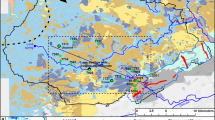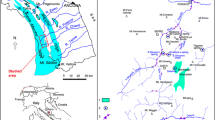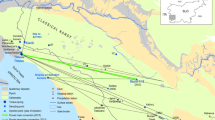Abstract
In the water-starved arid climate of Kuwait, useable (both fresh and brackish) reserves of groundwater constitute a strategic resource. Therefore, effective management policies are essential for ensuring sustainable management of the groundwater resources in the state. Although the general pattern of groundwater flow is known, the detailed pattern of the flow paths of water within the Kuwait aquifer system and the variation of hydraulic and transport properties are not known. Applied tracers are powerful hydrogeological investigative tools because the tracer application (source term) is controlled and well characterized which permits quantification of subsurface properties often unmatched by standard physical methods. Aquifer pumping tests and multi-well and multi-tracer (rhodamine-WT, fluorescein, sodium bromide) tests were carried out, under both natural and forced gradient conditions, at Al-Shegaya and Umm-Gudair sites. The objectives of the tracer tests are to determine the groundwater flow directions, flow rates, inter- and intra-aquifer hydraulic communications, effective porosity, dispersivity, etc., in the established groundwater well fields of southern Kuwait at Al-Shegaya Umm-Gudair. The tests involved drilling, construction and development of groundwater wells, and injection of tracers in the injection wells and monitoring its concentrations in the injection and monitoring wells. Inverse numerical modeling (MODFLOW and MT3DMS codes) was used for data interpretation. The Kuwait Group and Dammam Formation have a high degree of hydraulic separation, and it is likely that there is little recharge of the Dammam Formation from downward leakage from the Kuwait Group (at least in the study area). Groundwater resources in the Dammam Formation may be largely restricted to the flow into Kuwait from Saudi Arabia. The lower Kuwait Group aquifer has dual-porosity conditions: likely a rapid flow through fracture and/or conduit system (n eff = 0.5 %) and a slow flow through the formation (calcareous) matrix (n eff = 20 %), with very low dispersivity (longitudinal and transverse/vertical dispersivities of 0.1 and 0.01 m, respectively). The injection wells indicate more than one linear line segment in the tracer dilution plot (concentration in natural logarithmic vs. time), which suggests varying transmissivity across the well screen depths. The filtration velocity, hydraulic conductivity and transmissivity of the aquifers have also been estimated. At both the sites, the groundwater flow in the underlying carbonate formation is very slow (0.028 m/d). The hydrogeological parameters obtained from the present tracer study will be used for more reliable conceptualization, development and calibration of a suitable statewide flow and solute transport model for the regional groundwater system of Kuwait.

Source Mukhopadhyay et al. (1996)











Similar content being viewed by others
References
Abusaada M, Sauter M (2013) Studying the flow dynamics of a karst aquifer system with an equivalent porous medium model. Ground Water 51(4):641–650
Al-Awadi E, Mukhopadhyay A, Al-Senafy MN (1998) Geology and hydrogeology of the Dammam Formation in Kuwait. Hydrogeol J 6(2):302–314
Al-Ruwaih FM (1994) Pattern of ground water chemistry, Kuwait Group aquifers. J Environ Hydrol 2(1):24–25
Al-Ruwaih FM, Ben-Essa SA (2004) Hydrogeological and hydrochemical study of the Al-Shagaya Field-F, Kuwait. Bull Eng Geol Environ 63(1):57–70
Alshrahan AS, Rizk ZA, Nairn AEM, Bakhit DW, Alhajari SA (2001) Hydrogeology of an arid region: the Arabian Gulf and adjoining areas. Elsevier Science, Amsterdam
Al-Sulaimi JS, El-Rabaa SM (1994) Morphological and morphostructural features of Kuwait. Geomorphology 11:151–167
Axelsson G, Björnsson G, Montalvo F (2005) Quantitative interpretation of tracer test data. In: Proceedings world geothermal Congress, 2005, Antalya, Turkey, 24–29 April 2005
Barns GL (2010) Single well forced gradient tests: implications of aquifer physical heterogeneity and tracer behavior. Ph.D Thesis, to the University of Sheffield, p 309
Chua LHC, Roberton AP, Yee WK, Shuy EB, Edmond YM, Lo TT, Tan SK (2007) Use of fluorescein as a groundwater tracer in brackish water aquifers. Groundwater 45(1):85–88
Cooper HH, Jacob CE (1946) A generalized graphical method for evaluating formation constants and summarizing well-field history. Trans Am Geophys Union 27:526–534
Divine CE, McDonnell JJ (2005) The future of applied tracers in hydrogeology. Hydrogeol J 13:255–258
Drost W, Koltz D (1983). Aquifer characteristics. In: Guidebook on nuclear techniques in hydrology. Technical Reports Series No. 91, International Atomic Energy Agency, Vienna, pp 223–253
Ghasemizadeh R, Hellweger F, Butscher C, Padilla I, Vesper D, Field M, Alshawabkeh A (2012) Review: groundwater flow and transport modeling of karst aquifers, with particular reference to the North Coast Limestone aquifer system of Puerto Rico. Hydrogeol J 20(8):1441–1461
Hadi K, Saravana Kumar U, Al-Senafy M, Bhandary H (2016) Environmental isotope systematics of the groundwater system of southern Kuwait. Environ Earth Sci 75:1096. doi:10.1007/s12665-016-5886-9
Hamdan L, Mukhopadhyay A (1991) Numerical simulation of subsurface water rise in Kuwait City. Ground Water 29(1):93–104
Hantush MS, Jacob CE (1955) Non-steady radial flow in an infinite leaky aquifer. Am Geophys Union Trans 36:95–100
Harden HS, Chanton JP, Rose JB, John DE, Hooks ME (2003) Comparison of sulfur hexafluoride, fluorescein and Rhodamine dyes and the bacteriophage PRD-1 in tracing subsurface flow. J Hydrol 277(1):100–115
IAEA (1983) Guidebook on nuclear techniques in hydrology. Technical Reports Series No. 91, International Atomic Energy Agency, Vienna
Konikow LF, Reilly TE (1999) Groundwater modeling. In: Delleur JW (ed) The handbook of groundwater engineering. CRC Press, Boca Raton, pp 20-1–20-20
Lee JY, Cheon JW, Lee KK, Lee MH, Yun JK (2001) A study on tracer transport in a shallow porous aquifer. J Geol Soc Korea 37:297–308
Lee JM, Kim JW, Cheon JW, Yi MJ, Lee KK (2003) Combined performance of pumping and tracer tests: a case study. Geosci J 7(3):237–241
Mackay DM, Freyberg DL, Roberts PV (1986) A natural gradient experiment on solute transport in a sand aquifer 1. Approach and overview of plume movement. Water Resour Res 22:2017–2029
Mazurek M, Jakob A, Bossart P (2003) Solute transport in crystalline rocks at Äsp-geological basis and model calibration. J Contam Hydrol 61:157–174
McDonald MG, Harbaugh AW (1988) A modular three-dimensional finite-difference ground water flow model: U.S. Geological Survey Techniques of Water-Resources Investigation Report 06-A1, p 586
Molz FJ, Guven O, Melville JG, Nohrstedt JS, Overholtzer JK (1988) Forced gradient tracer tests and inferred hydraulic conductivity distributions at the mobile site. Groundwater 26:570–579
Mudarra M, Andreo B, Marín AI, Vadillo I, Barberá JA (2014) Combined use of natural and artificial tracers to determine the hydrogeological functioning of a karst aquifer: the Villanueva del Rosario system (Andalusia, southern Spain). Hydrogeol J 22:1027–1039
Mukhapadhyay A (1995) Distribution of transmissivity in the Dammam Limestone Formation, Kuwait. Ground Water 33(5):801–805
Mukhopadhyay A, Al-Otaibi M (2002) Numerical simulation of freshwater storage in the Dammam Formation, Kuwait. Arab J Sci Eng 27(2B):127–150
Mukhopadhyay A, Al-Sulaimi J, Barrat JM (1994a) Numerical modeling of ground-water resource management options in Kuwait. Ground Water 32(6):917–928
Mukhopadhyay A, Székely F, Senay Y (1994b) Artificial groundwater recharge experiments in carbonate and clastic aquifers of Kuwait. Water Resour Bull 30(6):1091–1107
Mukhopadhyay A, Al-Sulaimi J, Al-Awadi E, Al-Ruwaih F (1996) An overview of the Tertiary geology and hydrogeology of the northern part of the Arabian Gulf region with special reference to Kuwait. Earth Sci Rev 40:259–295
Omar SA, Al-Yacoubi A, Senay Y (1981) Geology and groundwater hydrology of the State of Kuwait. J Gulf Arab Penins Stud 1:5–67
Peng WS, Hampton DR, Konikow LF, Kambham K, Benegar JJ (2000) Can contaminant transport models predict breakthrough? Ground Water Monit Rem 20(4):104–113
Pitrak M, Mares S, Kobr M (2007) A simple borehole dilution technique in measuring horizontal ground water flow. Ground Water 45:89–92
Plata BA, Araguas AL (2002) Detection and prevention of leaks from dams. A.A. Balkema Publishers, Rotterdam, p 419
Ptak T, Piepenbrink M, Martac E (2004) Tracer tests for the investigation of heterogeneous porous media and stochastic modelling of flow and transport—a review of some recent developments. J Hydrol 294(1–3):122–163
Rose PE, Mella M, Kasteler C, Johnson SD (2004) The estimation of reservoir pore volume from tracer data. In: Proceedings 29th workshop on geothermal reservoir engineering, Stanford University, USA, pp 330–338
Sanford WE, Cook PG, Dighton JC (2002) Analysis of a vertical dipole tracer test in a highly fractured rock. Groundwater 40:535–542
Saravana Kumar U (2013) Using isotope techniques to evaluate groundwater hydrology (KUW 7001). End-of-Mission Report (KUW 7001 02), IAEA, Vienna, p 19
Senay Y, Hamdan L, Yacoubi A (1987) Study of the subsurface water rise in the residential areas of Kuwait, vol 3: hydrogeology. Kuwait Institute for Scientific Research, Report No. KISR2227, Kuwait
Taylor CJ, Greene EA (2001) Quantitative approaches in characterizing karst aquifers. In: Kuniansky EL (ed) US Geological Survey Karst Interest Group proceedings. U.S. Water-Resources Investigations Report 01-4011, pp 164–166
Walton WC (1960) Leaky artesian aquifer conditions in Illinois. Illinois State Water Survey Report of Investigations 39
Walton WC (1962) Selected analytical methods for well and aquifer evaluation. Illinois State Water Survey Bulletin 49
Zheng C, Wang PP (1999) MT3DMS: a modular three-dimensional multi-species model for simulation of advection, dispersion and chemical reactions of contaminants in ground water systems: documentation and user’s guide. U.S. Army Engineer Research and Development Center, Vicksburg, Report SERDP-99-1, Mississippi
Acknowledgments
The authors would like to thank the Kuwait Institute for Scientific Research and the Kuwait Foundation for the Advancement of Sciences (KFAS) for funding the project. The authors would also like to express their gratitude to their colleagues (Mr. Bandar Al-Salman, Ms. Ruby Crasta and Ms. Sushma Bangera) for their help at various stages of the investigation. The support received from consultant M/s. Schlumberger Water Services during the execution of the study is sincerely thanked.
Author information
Authors and Affiliations
Corresponding author
Rights and permissions
About this article
Cite this article
Hadi, K., Saravana Kumar, U., Al-Senafy, M. et al. Multi-well and multi-tracer tests to characterize the groundwater aquifers in southern Kuwait. Environ Earth Sci 75, 1340 (2016). https://doi.org/10.1007/s12665-016-6143-y
Received:
Accepted:
Published:
DOI: https://doi.org/10.1007/s12665-016-6143-y




